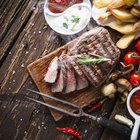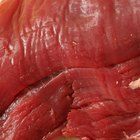
Jupiterimages/Polka Dot/Getty Images
Animal casings give sausage links their shape, but you can replace casings with any food-safe material that can hold ground meat, fat and spices together. Plastic wrap is the best choice, because it's airtight and easily removable. You have to add a secondary binder to sausage when you don't use a casing to help it hold together, and gently poach it to set its shape. But after you poach the sausage and remove the plastic, you can grill, fry or roast it as you normally would.
Blending the Spice Mix
Add 1/2 tablespoon of kosher salt per pound of meat and fat to a mixing bowl to use as the base for the spice mix.
Toast any whole spices, such as peppercorns, fennel seeds or cardamom pods, in a dry saute pan over medium-low heat until aromatic, about two to three minutes.
Grind the toasted spices in a spice grinder and add them to the mixing bowl, along with any other ground dried spices.
Mix the spices using a whisk and set aside. Plan for 1/4 cup of spice mix per pound of meat and fat for a moderately spicy sausage.
Mixing the Forcemeat
Chill the meat-grinder attachment and accessories on your mixer in the freezer while you prepare the meat, fat and spices, collectively referred to as forcemeat.
Dice 1 part each lean pork, secondary meat and pork fatback into 1/2-inch pieces and place them in a bowl or container. Use any relatively lean protein for the secondary meat, such as pork loin, pork shoulder, beef chuck, chicken breast, lamb shoulder and venison.
Place the diced meat and fat in the freezer while you assemble the stand mixer and grinder. Place about 1 cup of ice water in the freezer. Fill a mixing bowl with ice and place a second mixing bowl on top of it. Set the mixing bowls under the grinder attachment so the forcemeat will drop into it.
Grind the meat and fat into the mixing bowl. Replace the grinder attachment with the paddle attachment.
Add a secondary binder to the forcemeat. Two egg yolks, 1/4 cup of cooked rice or 1/2 cup of bread soaked in milk per pound of forcemeat all work. Mix the forcemeat on low using the paddle attachment until combined and sticky to the touch. Add a few tablespoons of ice water during mixing.
Take a small portion of the forcemeat out of the bowl and put the rest of it in the refrigerator. Roll the portion of forcemeat into a tight patty and fry it in a saute pan for a taste test. Adjust the salt and spices in the forcemeat if needed.
Chill the forcemeat in the refrigerator for three to 12 hours. The forcemeat will cure, the flavors will meld, and the binder will coalesce with the proteins and fat.
Forming the Links
Divide the forcemeat into 1/4-pound portions. Place a 12-inch by 12-inch piece of quality plastic wrap on a work surface.
Roll a portion of forcemeat into a tight ball then shape it into a 1- to 1 1/2-inch cylinder. Position the cylinder horizontally about 3 inches up from the bottom edge of the plastic wrap.
Wrap the plastic around the cylinder of meat tightly. Roll the cylinder of meat forward until it's fully wrapped in plastic. Twist the ends of the plastic wrap in opposite directions until the link is tightly encased. Tie a knot in the plastic at each end of the link. Form the rest of the links using the same technique and place them in the refrigerator.
Bring a pot of water to 180 degrees Fahrenheit, or until it barely simmers. Place the sausage links in the water.
Poach the sausage for 10 minutes after the water returns to a simmer. Check the internal temperature of a link to make sure it has reached 165 F in the center. Unwrap the sausages and eat them as is, or quickly sear them in a pan or on the grill before serving.
Related Articles

How to Make Stove-top Meatloaf

How to Make Venison Bratwurst

How to Brine a Smoked Beef Brisket

How to Smoke Sausage in a Meat Smoker

How to Cook Barbecue Deer Meat in a ...

Types of Portuguese Sausage

How to Use Egg in a Burger

How to Cook Dominican-Style Steak

Do You Use Egg White for Binding ...

How to Trim and Tie a Beef Tenderloin

How to Store Cooked Ground Beef

How to Cook Pork Hamonado

How to Marinate a Top Round Roast

Shank Ham Cooking Directions

How to Cook Chorizo in the Oven

How to Cook a Country Sausage Stuffed ...

Cooking Scramble Burgers

How to Inject a Brisket

Freeze-Ahead Meals With Pork Chops
How to Slow Cook a Pot Roast With Beef ...
References
- The Professional Chef 9th Edition; The Culinary Institute of America
Writer Bio
A.J. Andrews' work has appeared in Food and Wine, Fricote and "BBC Good Food." He lives in Europe where he bakes with wild yeast, milks goats for cheese and prepares for the Court of Master Sommeliers level II exam. Andrews received formal training at Le Cordon Bleu.
Photo Credits
Jupiterimages/Polka Dot/Getty Images